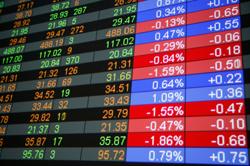 Now we’re back on track to talk about some new investment strategies: they’re called ETFs, which stands for Exchange-Traded Funds.
Now we’re back on track to talk about some new investment strategies: they’re called ETFs, which stands for Exchange-Traded Funds.
Remember waaaayyy back at the beginning of our journey here together, I talked about mutual funds and said that they were baskets of stocks/companies that you could buy instead of buying individual stocks? (You do remember, don’t you? And if you have short-term memory problems, you can always go back to the archives of these articles on The Savvy Gal Web site.)
Well, there’s now another way to buy baskets of stocks: Exchange-Traded Funds. This is a relatively new (1993 saw the first ETF) investment vehicle that is really a combination of a mutual fund and an individual stock. The major difference between an ETF and a mutual fund: you can do anything with an ETF that you can do with a stock — trade it during the day when the market is open, buy on margin, sell short, buy through your brokerage firm rather than a company which sells the product, like a mutual fund company. Anything that can be done with an individual stock can be done with an ETF. They have a lot more flexibility than a mutual fund.
Now, if you’re ever on “Jeopardy,” here’s a question you might be able to answer: what was the first ETF? The answer is that the American Stock Exchange back in 1993 started selling what is commonly called a “Spider,” a nickname for S&P Depositary Receipts. This is the American Stock Exchange’s version of the index mutual fund we’ve talked about before. In fact, the American Stock Exchange has always led the charge where ETFs are concerned.
Today every major mutual fund company has a basket of ETFs you can also buy, along with banks such as Barclays. New companies spring up all the time offering a plethora of ETFs you can buy to suit your desires and needs. They are as specific as mutual funds: sectors, geographical areas, income-producing, growth, etc., etc. And, as with mutual funds, there are now newsletters and commentators who specialize in giving the general public tons of information about ETFs: which ones are doing well, which ones might do well in the future, and so on.
I like ETFs because they’re much simpler than comparable mutual funds. You don’t need to investigate whether or not the fund is loaded or not (loaded equates to a commission, which takes away from the amount of your investment initially); ETFs are not loaded … ever. You don’t need to wait until the end of the market day to see the value of your investment as you do with mutual funds. You can check the value of the ETF any time during the market day just as you would check a particular stock. And now that you can find so much information about ETFs, there’s no reason to ignore them.
So, if you like baskets of stocks instead of individual ones, check out ETFs. You can Google Exchange Traded Funds and be sent to dozens of Web sites that will give you not only information and research tools, but lists of the top ETFs — those that are doing well in the current market — and the worst — the ones you want to stay away from.
When my investment clubs first started over a decade ago, we didn’t invest in mutual funds because they were too complicated for our needs in terms of buying and then selling at the appropriate times. So we avoided them, even though some of the ladies in the groups would have preferred buying baskets of stocks for safety instead of individual equities. Today, however, we buy ETFs all the time just like we buy particular stocks, because they trade so easily. Thank you, American Stock Exchange, for making our investing life so much easier!
What will be the next new thing in the investment world? Who knows! But that’s what makes this all so very exciting and challenging.
